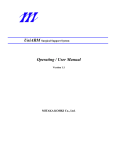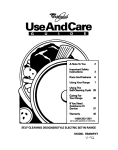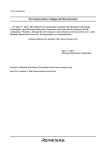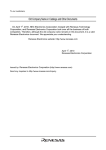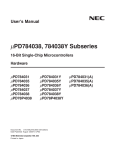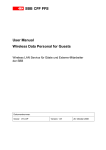Download Mitaka Kohki PSMS2 User`s manual
Transcript
Operating / User’s Manual MITAKA KOHKI Co., Ltd. POINT SETTER MODEL: PSMS2 PSMS2-M01 Last update February 14, 2010 INTRODUCTION Thank you for purchasing the MITAKA Point Setter (holding system for surgical instruments). MITAKA KOHKI Co., Ltd. has been producing many products in the area of astronomical instruments, industrial measuring instruments, and medical instruments since 1966. The pride of true workmanship goes into each component of all our products. We believe that you will fully recognize the high quality of our products with the use of the Point Setter. MITAKA KOHKI originally created the Point Setter as a holder arm to retain a brain spatula. Since its original creation, there have been a number of improvements made to the Point Setter, including its expanded use as a holder for various other surgical instruments. It is especially valuable for the holding of an endoscope, which has lately attracted considerable attention in the endoscopy field. Other uses for the Point Setter include the holding of a retractor, a respirator tube, a CCD camera, and a magnetic stimulation coil. Note: In the USA, the Point Setter is FDA 510k approved only for use in holding an endoscope. MITAKA KOHKI asks its USA customers to contact Mitaka USA at (888) 244-6173 regarding other possible FDA approved uses for the Point Setter. Furthermore, if you have any questions regarding its intended use, please contact us; we are eager to help our customers in any way that we can. -2- SAFETY GUIDELINES (Read carefully before use) IMPORTANT: ◆ The POINT SETTER was designed according to standard IEC 6001-1/EN 60601-1. ◆ Repair, remodeling, maintenance and other technical services must be performed exclusively by an appointed service person of MITAKA KOHKI or those technicians trained by MITAKA KOHKI. MITAKA KOHKI’s guarantee will not cover any mechanical failure or liability caused by an act not in accordance with this instruction. ◆ All the parts necessary for technical services or repair must be replaced with MITAKA KOHKI products only. ◆ Please use this instrument carefully in accordance with the instructions contained in this Operating/User’s Manual. ◆ Special attention should be given to the following warnings: CAUTION: In the USA, Federal law restricts this device to sale or use by or on the order of a physician. ! DANGER! This indicates possible death or serious injury in case of misuse. ! CAUTION! This indicates possible damage to property or injury of persons in case of misuse. ! WARNING! This indicates possible failure to make full use of the Point Setter. -3- ! CAUTION! Conditions of installation and operation must correspond to microsurgical requirements and standards: ◆ Careful handling ◆ Clean environment ◆ Avoidance of extreme mechanical stress or impact ◆ Low vibration ◆ Check for proper condition of the unit and its accessories prior to start up ◆ Do not pull on the cable ◆ Do not hold objects which exceed the maximum permissible weight of 2kg (4.4 lbs) ◆ In case of mechanical failure, contact the manufacturer or the distributor ◆ Never disassemble or overhaul the apparatus ◆ Never modify, alter or disassemble the apparatus in any way ◆ If malfunction or damage of the Point Setter occurs, display an “Out of Order” sign on the instrument and immediately contact the manufacturer or its agent ◆ Monthly perform Operational Test shown in Section 5 of this document -4- TABLE OF CONTENTS Page Introduction ---------------------------------------------------------------------------------------Safety Guidelines----------------------------------------------------------------------------------Table of Contents --------------------------------------------------------------------------------1. Summary-------------------------------------------------------------------------------------- 2 3 5 6 2. Parts List---------------------------------------------------------------------------------------3. Handling Instructions-----------------------------------------------------------------------A. Sterilization ------------------------------------------------------------------B. General care of Point Setter Surfaces------------------------------------- 7 9 9 12 C. D. E. F. 4. 5. 6. 7. Before Draping Patient --------------------------------------------------- 13 Draping the Point Setter ---------------------------------------------------- 15 Attaching the Endoscope to the Point Setter ----------------------------- 16 OR Table Adapter Brake Knobs ------------------------------------------- 18 Further Safety Instructions --------------------------------------------------------------Operational Test -----------------------------------------------------------------------------Troubleshooting ---------------------------------------------------------------------------Labeling -------------------------------------------------------------------------------------- 19 20 23 24 8. Technical Data ------------------------------------------------------------------------------- 25 9. Addresses ------------------------------------------------------------------------------------ 27 Annex: EC DECLRATION OF CONFORMITY EDITION PSMS2-M01 December 26, 2007 -5- 1. SUMMARY The Point Setter acts as a third arm that can firmly hold an endoscope for a surgeon. Surgeons can operate it quite easily with only one switch required to allow it to be free or to be locked. Surgeons can position their surgical instruments in the desired angle with the use of the Point Setter. The Point Setter has a lock knob and guard panels for its switch to prevent it from coming out of the locked mode, allowing surgeons to use it with confidence. The Point Setter’s arm can be attached on either side rail of the operating table through an OR table adapter. The OR table adapter can be adjusted to allow the arm to be at the best position for the surgeon. The Point Setter has a reliable safety mechanism which causes the arm to be locked when the power or nitrogen gas pressure is down. -6- 2. Part List ① ③ ② ③ ② ① ④ ⑤ ①Endoscope holder ②Free switch ③Safety lock knob ④Arm ⑤OR table adapter ⑥Manual ball joint ⑥ -7- Accessories for Endoscope “endoscope holder” PSBU-045 PSSU-040 Endoscope Holder Endoscope Holder (Universalφ10~15mm) (Universalφ5~10mm) PSBU-046 PSFS-070 Endoscope Holder Endoscope Holder (Universalφ10~15mm, Karl Storz Flexible Pediatric 7mm width) PSNS-060 PSWH-050 PSZH-060 PSGH-055 Nitrogen hose with Endoscope Holder Endoscope Holder Endoscope Holder Shrader connector, (for Wolf scope) (for Zamorano scope) (for Gaab scope) 6m length NOTE: There are many kinds of accessories. The surgeon can choose these accessories in accordance with the kind of endoscope he uses. -8- 3. Handling Instructions A. Sterilization of Endoscope Holder Warning: The Point Setter arm and OR table adapter are never sterilized. Instead they are covered by a sterile drape as referenced in 3. D. (page 15). Sterilize the endoscope holder using the following instructions. Please follow these instructions carefully. CLEANING AND STERILIZATION OF REUSABLE ACCESSORIES FOR THE MITAKA POINT SETTER (“ENDOSCOPE HOLDER”) NOTE: Throughout this sterilization section, the reusable sterilizable accessories that are attached to the Point Setter arm through the sterile drape, as shown on page 10, are collectively referred to as “endoscope holder” for purposes of simplification. Warning: The endoscope holder must be thoroughly cleaned and sterilized according to validated infection control procedures prior to use and subsequent reuse. Caution: Any deviations from the recommended parameters for cleaning and sterilization should be validated by the user. ■ Preparation for Cleaning and Sterilization Place the endoscope holder in a container and soak with a neutral pH (pH 5.0 to 8.0) enzymatic cleaning solution (e.g., Enzol, Metrizyme, or equivalent per manufacturer’s instructions) immediately after use to prevent blood, protein and other contaminants from drying onto the endoscope holder. ■ Water Quality Requirements Distilled water is recommended for cleaning and rinsing of the endoscope holder. -9- ■ Cleaning Instructions for the Endoscope Holder Caution: Wear protective gloves, clothing, and a face mask for cleaning of contaminated endoscope holder. Caution: Hot water (greater than 49 degrees C or 120 degrees F) will alter organic materials (blood and tissue), making them difficult to remove. 1. The endoscope holder should be disassembled. 2. Thoroughly rinse all parts to remove all gross debris. 3. Manual cleaning is recommended. However, difficult to reach areas can be cleaned using an ultrasonic cleaner. It is important to follow the manufacturer’s instructions for operating the ultrasonic cleaner. 4. Completely immerse the endoscope holder in a neutral pH enzymatic cleaning solution (e.g., Enzol, Metrizyme or equivalent per manufacturer’s instructions) and distilled water. Use water that is less than 49 degrees C or 120 degrees F to clean the endoscope holder; blood and tissue will become difficult to remove using hot water. Mitaka does not recommend the use of detergents alone, as they contain high concentrations of surfactants which can leave a film on the endoscope holder. 5. Remove any residual blood, protein material and contaminants from the endoscope holder with brushes, sponges, soft cloths or a cotton cloth applicator. 6. Clean the inside of the sheaths and outer tubes with the appropriate size cleaning brushes. 7. Cleaning brushes should be cleaned and subjected to high level disinfectant or sterilization daily. 8. Triple rinse the endoscope holder with distilled water for a minimum of one minute for each rinse. The rinse water should be discarded at the end of each rinse, as it will be contaminated with the cleaning solution. Thorough rinsing of the endoscope holder is necessary for removing any debris or detergent which could interfere with sterilization. 9. Dry the endoscope holder with a lint-free soft cloth or filtered compressed air. -10- 10. After cleaning, inspect the endoscope holder for cleanliness and damage. 11. Before sterilization, lubricate all moving parts of the endoscope holder with a non-silicone water soluble instrument milk or lubricant (e.g., Codman Preserve per manufacturer’s instructions). Silicon- or oil-based lubricants are not recommended for use because sterilants cannot penetrate the silicone or oil. ■ Steam Sterilization Caution: The recommended sterilization parameters are only valid with sterilization equipment that is properly maintained and calibrated. Caution: Any deviations from the recommended parameters for sterilization should be validated by the user. 1. Place the endoscope holder in a sterilization tray. 2. Mitaka has validated the following steam sterilization methods: a. Pre-Vacuum Pre-vacuum or high vacuum sterilization consists of four basic phases: A conditioning phase, an exposure phase, an exhaust phase, and a drying phase. The conditioning phase removes air form the chamber by pulling a vacuum and then warms the endoscope holder by injecting steam. Sterilization occurs during the exposure phase when the chamber reaches a temperature of 270 degrees F and pressure of 27 psi. The exposure phase in a pre-vacuum type of sterilizer is 4.0 minutes. The exhaust phase removes the steam from the chamber. The drying phase is accomplished by pulling an additional vacuum and allowing the endoscope holder to dry under vacuum for approximately 20 minutes. The following conditions have been used to validate sterilization procedures in a pre-vacuum sterilizer: Temperature: Pressure: 132.2 to 133.3 degrees C or 270 to 272 degrees F 1.85 bar or 27 psi Exposure time: 4 minutes -11- b. Flash Sterilization Flash sterilization can be accomplished in either a pre-vacuum or gravity displacement type of sterilization unit. Flash sterilization in a gravity displacement unit proceeds without a drying phase. We have validated flash sterilization using a gravity displacement unit and the following conditions: Temperature: 132.2 to 133.3 degrees C or 270 to 272 degrees F Pressure: 1.85 bar or 27 psi Exposure Time: 10 minutes 3. Trays should be positioned in the sterilizer so that there is adequate circulation and penetration of steam, air removal and condensate drainage. 4. At the completion of the steam sterilization cycle, the endoscope holder should remain untouched until adequately cooled. B. General Care of Point Setter Surfaces – 1. Caution: Any form of grease should never be used on the Point Setter. 2. Care should be given to not touch black ball joints with your hands as there may be some grease on your skin that can be transferred to the Point Setter. 3. The Point Setter is best cleaned by the use of pure alcohol. Operating rooms often have individually packaged alcohol pads that can be rubbed on all of the surfaces of the Point Setter. 4. If one is cleaning the black ball joints then it will be required to move the arm to different positions to expose entire surface of black ball to the alcohol. There are One manual black ball joint and three pneumatic black ball joints -12- C. Before Draping Patient Perform this part before covering the patient with sterile cloth. Set up OR table adapter on the side rail of the operating table. Try to locate the arm at the best position during operating considering the C-arm X-ray or other possible interfering surgical instruments. We recommend that you confirm interference using real equipment and finish this setup before beginning operating. Otherwise, changing the position of the arm during the operation can be very difficult. To change the OR table adapter during surgery a non-sterile person may be needed. 1. Setup OR table adapter to the operating table Disengaging the cap (right and left) enables you to replace each part. Select the order according to the setup positioning to the operating table or operating method. Clamp the OR table adapter firmly to the side rail. Shake unit to insure that it is secured firmly to the side rail. 2. Setting up the arm Set up Point Setter arm. Make sure that the arm is securely clamped to the OR table adapter. -13- 3. Connect hoses Connector from Connector of Nitrogen hose “Point Setter” arm Plug the arm hose into the nitrogen connector of the hospital. 2 Set pressure to 6 ~ 8 kgf/cm or 90 ~ 115 psi or 6.2 to 7.9 bar. (PSNS-060) NOTE: The PSMS comes with a male Schrader connector. Other connectors or adapters can be acquired. a male Shrader connector (PSNS-060) ! CAUTION! Nitrogen gas or compressed air pressure should be 2 6 ~ 8 kgf/cm or 90 ~ 115 psi or 6.2 to 7.9 bar. Excessive pressure is very dangerous. 4. Operational check Perform operational check of the Point Setter and make sure the range of motion is appropriate. Do this before starting surgery and follow Section 5 on a monthly basis. NOTE: If instrument does not release completely or is slow to release, then recheck nitrogen or air pressure. Lower than recommended pressure will cause poor performance. -14- D. Draping the Point Setter 1. Cover the Point Setter with the drape. 2. Secure the drape with adhesive tape, which is attached to the drape. When securing the drape, do not tighten it excessively. The adhesive tape -15- E. Attaching the Endoscope to the Point Setter 1. Installing an endoscope Attach the endoscope to the endoscope holder after sterilization in advance. Use the appropriate endoscope holder for each endoscope. Secure firmly so no movement is present. Install an endoscope holder after sterilization over the drape. Secure firmly so no movement is present. NOTE: When the endoscope holder is installed on the tip of Point Setter, do not tear drape. The endoscope holder goes over the sterile drape. NOTE: The surgeon may choose to connect the endoscope before or during surgery. 2. Adjustment of manual ball joint For optimal positioning, adjust the angle with a manual ball joint adjust knob. 3. Safety lock knob ! CAUTION! During operation the safety lock knob must remain in the "LOCK" position except when moving the arm. NOTE: When safety lock knob is in the “Lock” position, it prevents accidental release of the arm. -16- 4. Ready to use Pushing free switch (which is colored gold) allows the arm to move freely. The arm will remain locked at the point by releasing the free switch. ! CAUTION! Safety instructions Operating table Since the Point Setter is attached to the operating table, the strength of the side rails of the operating table affects the stability of the Point Setter. Before using the Point Setter, the side rails of the operating table must be thoroughly checked. If the operating table has a loose screw, stop using the Point Setter. Since some tables have a deflection due to the structure, use the Point Setter fully considering the characteristics of each operating table. Point Setter It should be noted that when the Point Setter remains free, the entire weight of an endoscope and two joints of the arm are applied to the hands of the doctor. Especially during operation it is easy to fail to remember the sense of weight when moving the arm at intervals. Particular care should be paid to hold the Point Setter with both hands and not to drop the Point Setter when it remains free. Care should be made to insure that brakes are fully locked before letting go of the Point Setter. -17- F. OR Table Adapter Brake Knobs – Special Function This knob enables the fitting to rotate. When the knob is in the way, Pull it straight out and rotate. When the knob causes interference. The position of the knob can be adjusted by pulling straight out and rotating the knob. -18- 4. Further Safety Instructions 1. The apparatus must be operated only by an expert. (USA requires a physician approval.) 2. In installing the apparatus pay attention to the following matters: (1) Do not install on a wet place and be sure not to splash water or other liquid. (2) Do not use this apparatus outside the operating room. (3) Great care is necessary in handling the apparatus to avoid a dent or a scrape. (4) Be sure to firmly tighten all clamps and brakes. (5) The maximum permissible weight must not exceed 2kg. (6) Do not use parts which are not products of MITAKA KOHKI Co. Ltd. 3. Pay careful attention to the following matters before use: (1) Be sure to perform operational check before operation. (2) Handling of the apparatus requires great care. In case of knocking or hitting the apparatus in use, be sure to stop using it and contact MITAKA KOHKI Co. Ltd. (3) Make sure that each cable has no damage. In case of finding defects, be sure to stop using the apparatus and contact MITAKA KOHKI Co. Ltd. (4) Use nitrogen gas or pressurized air with designated operating pressure. (5) Be sure to securely connect hoses of nitrogen gas or pressurized air. 4. Pay careful attention to the following matters in use: (1) Care must be taken not to exceed time needed for diagnosis and treatment. (2) Constant observation is required over the apparatus and the patient. (3) The operating room temperature should be 15~29 degrees C or 59~84 degrees F, and humidity 45~90%, respectively. 5. Pay careful attention to the following matters after use: (1) Do not disconnect hoses by pulling out with excessive force. (2) The storage place requires the following care: a. Store in a dry place. Do not splash with water or other liquid. b. Do not store the apparatus in a place susceptible to vibration or shock. c. The storage temperature should be room temperature (approximately 20 degrees C or 68 degrees F). (3) Attachments and hoses should be stored together after cleaning. (4) Do not use an organic solvent to clean the apparatus. (5) If you recognize damage or deformation on the surface of the hose, stop using the apparatus and contact MITAKA KOHKI for inspection. 6. Failure: In the event of a failure, indicate the problem properly. An appointed MITAKA KOHKI Co. Ltd. technical service person or those who are trained by MITAKA KOHKI Co. Ltd. must repair the apparatus. 7. Maintenance: Be sure to perform an operational check before use and make sure the unit has no damage or malfunction. In additional to an operational check each use Mitaka Kohki recommends that the Point Setter inspection and operation test in Section 5 below be performed at least monthly. -19- 5. POINT SETTER inspection & operation test (Recommend Monthly Test) No 1 Measures inspect the outside look 2 inspect the air hoses and connectors 3 inspect the nitrogen gas or air pressure supply 4 Inspect the retention. If Point Setter does not hold 2 kg or more before brakes slip return the unit to factory for repair required result no damage, no dirt or no looseness any parts no damage all connectors are connected accurately 6kgf/cm2~8kgf/cm2 or 6.2 to 7.9 bar (or 90 – 115 psi) Never exceed maximum pressure Retention >2kg or greater of brake 2, 3, 4, & 5 -20- Retention > 2 kg or greater of Brake 1 5 Inspect the retention of brake 1 by pushing the torque gauge sideways on the arm switch is inactivated when the knob is at LOCK 6 inspect the lock knob 7 8 9 switch on switch off switch off slowly all brakes get free all brakes get fixed immediately all brakes get fixed POINT SETTER OR table adapter inspection and operation test No 1 Measures inspect the outside look required result no damage, no dirt or no looseness any parts -21- these parts must be firmly fixed with the clamps 2 inspect the clamps 3 inspect firmness the entire system must be able to be firmly fixed -22- 6. Troubleshooting Failure No function at all Remedy Connect Nitrogen Hose Page 14 2 Holding force too weak Use pressure 6~8 kg/cm or 6.2 to 7.9 bar Or 90-115 psi 14 Turn the safety lock knob on 16 Check weight of the instrument, Maximum load is 2 kg 4 19 14 Check joints of arm Endoscope or device slips 19 13 Check each of the clamps 16 18 Check the operating table 17 If failures cannot be remedied, contact our local representative for service. -23- 24 7. Labeling ④ ⑤ ① ② ③ ⑤ ① ⑤ ⑤ ⑤ ⑤ ⑤ ⑤ ⑤ ⑤ ① ② ④ ③ ⑤ -24- Make sure that part is securely clamped. 8. Technical Data POINT SETTER Arm Joint number Arm length Catalog No. PSMS2 : : Weight : Maximum load : Model No. : OR Table Adapter Joint number Weight Model No. : : : 6 (includes 1 manual joint) 650 mm (nominal length) 6 kg 2kg PSMS2 3 axes and 1 slide 6 kg PSMS2 -25- Instrument holders Standard holders : Catalog No. Universal holder, small (φ5~10mm) PSSU-040 Universal holder, large (φ10~15mm) PSBU-045 Universal holder, pediatric (φ10~15mm) PSBU-046 Flexible Storz endoscope PSFS-070 Optional holders : Holder for endoscope Wolf Zamorano PSWH-050 PSZH-060 Gaab PSGH-055 Holder for brain spatula PSBH-075 Others Special holder, ordered (Inquire with local representative for service) Other parts Nitrogen Hose – Shrader Connecter Sterile Drape (Japan) PSNS-060 Sterile Drape (Outside Japan) 4667 -26- 9. Address as of December 26, 2007 Manufacturer of POINT SETTER Mitaka Kohki Co., LTD. 1-18-8 Nozaki, Mitaka, Tokyo 181-0014 Japan Work: 81-422-49-1491 Fax: 81-422-49-1117 Local representatives for service EUROPE, other Countries (including USA): KARL STORZ GMBH & CO. Mittelstrasse 8, D-78532 Tuttlingen, Germany phone: fax: +49 – 7461 – 7080 +49 – 7461 – 76874 USA,: MITAKA USA, Inc. 2337 Lucky John Drive, Park City, Utah 84060, USA phone: +1 – 888 – 244 – 6173 fax: +1 – 435 – 649 – 2236 JAPAN: MITAKA KOHKI CO., LTD. 1-4, Ohsawa 5-chome, Mitaka-shi, Tokyo, 181-0015, Japan phone: fax: +81 – 422 – 32 – 1491 +81 – 422 – 31 – 1117 -27- MITAKA KOHKI CO., LTD. 1-18-8 Nozaki, Mitaka, Tokyo 181-0014 Japan Work: 81-422-49-1491 Fax: 81-422-49-1117 e-mail: [email protected] http://www.mitakakohki.co.jp -28-




























